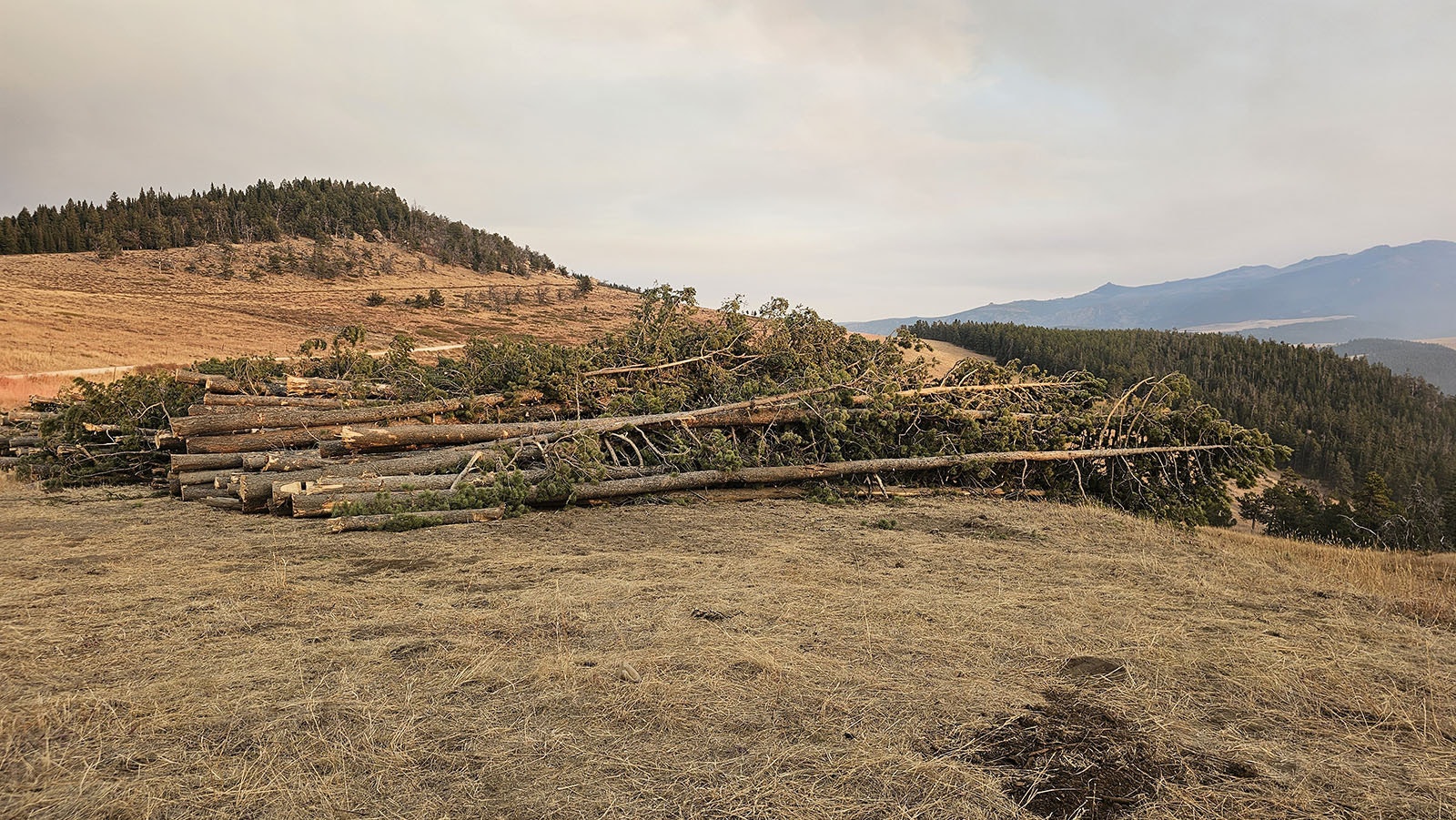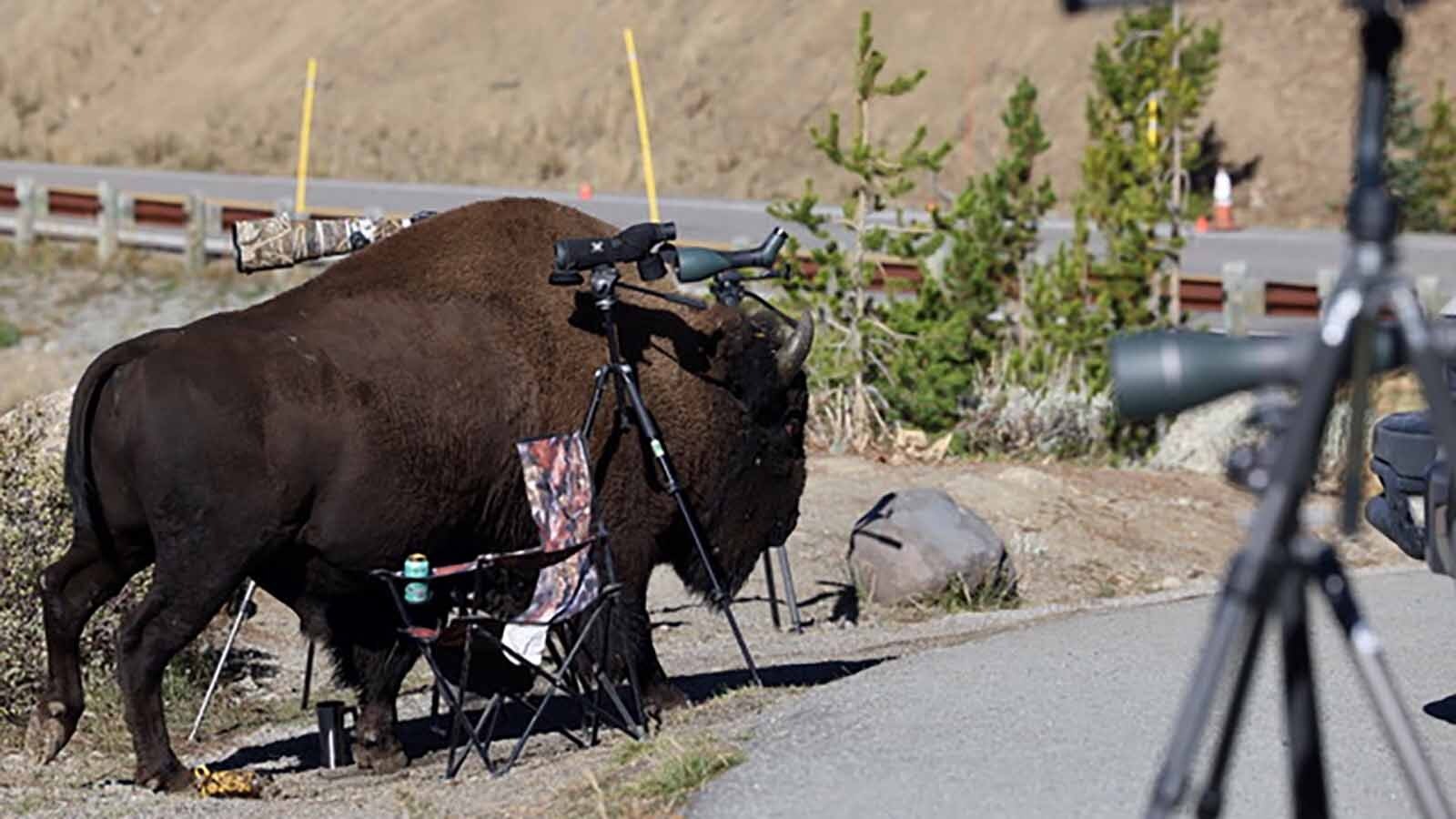Wildfires typically force the clear-cutting of tons of timber to create wide enough breaks to stop destructive runs across the land.
During last year’s Elk Fire, for example, more than 6,000 tons of wood were cut to make fire breaks, including the big fire line that was created along Red Grade Road.
Typically, all of the wood that’s cut down during such a firefighting operation would be left to rot. At most, it might get chipped into mulch or even burned later, to reduce available fuel on the forest floor.
This time that’s not what’s going to happen. Instead of going to waste, the 6,000 tons of wood cut during the Elk Fire is going to be sold to a contractor in Buffalo.
It’s an incredible amount of wood, according to JL & Sons owner, Joe Landsiedel, who was the sole bidder for the product.
“It’s hard to get your mind wrapped around how much wood that is,” he told Cowboy State Daily. “To see 200 trucks lined up in one gravel pit, it’s just a lot of wood.”
Landsiedel doesn’t have just one destination for the wood. Some of it will be for a post-and-pull type of operation for fence posts and fence rails. Some will be firewood, and some will be saw timber.
A Game Of Connect The Dots
The saw timber, which is the highest value wood, is likely headed to a mill in Montana, about 350 miles away. That’s the nearest mill that uses the type of wood that grows in the Bighorn forest.
“There is (a mill) in Hulett, but they don’t buy this species,” Landsiedel said. “So that’s the other issue we have is that the mills we do have left in Wyoming, especially like the one in Hulett, they’re specifically ponderosa pine mills.”
Most of the species growing in the Bighorn forest are lodgepole pine, Douglas fir, and spruce, Landsiedel said.
“(Environmentalists) have starved all these mills out of existence,” Landsiedel said. “So, if there’s nobody to buy it, that really curtails anybody logging it. So, I do a lot of firewood and things like that.”
Since the COVID-19 pandemic, Landsiedel has noticed a number of people setting up tiny mills in their backyard as well.
“All these mom-and-pop mills in people’s backyard can actually use stuff like this if you can connect the dots and get it to them,” Landsiedel said. “But I’ve been here 34 years, so it’s taken me that long to have a customer base to where I can look at a pile like that (from the Elk Fire) and make it go away.”
For Landsiedel, it would be a lot cheaper to take it to one, big sawmill than to drive around looking for tiny operations.
“We just don’t have that luxury, though,” he said. “Wyoming’s sawmill in Sheridan went out in ’08, and there hasn’t been anything around here ever since that’s near to me.”

Trying A More Proactive Approach
The groundwork for a different approach in how at least some of the wood was cut for fire breaks during the Elk Fire was actually laid long before the fire happened, according to Assistant State Forester, Matt Marshall, who said the Bighorn forest has been and continues to be highly proactive.
“The (U.S.) Forest Service has something it calls PODs, which is an acronym for Potential Operational Delineation,” Marshall said. “And what that means is they’re looking for strategic locations for fire lines to be put in case of fire.”
Ideally, such POD lines would be cut long before there is a fire or even any smoke detected. Then they’re already in place as a contingency for firefighters to make a stand, if a fire is resisting suppression and control.
During the Elk Fire, such POD lines had already been identified, Marshall said, and that gave everyone involved a little more time for discussion about how best to approach the work.
“We typically send an agency representative to really, any fire, but especially these large fires,” Marshall said. “So, our agency representative was part of the conversation where they started to talk about how to design that line.”
District Forester Jacob McCarthy, who works out of the Buffalo field office, was that representative.
He told Cowboy State Daily he knew some of the wood in question was viable for lumber mills, and he felt strongly, given how Wyoming timber industries have been struggling, that it should be harvested in a way that makes it commercially usable, so that it wouldn’t get wasted.
“The timber program manager for the Bighorn National Forest was weighing in, as well as myself, and saying that we should just full-blown go after it with a mechanized, ground-based logging operation,” McCarthy said. “So not just the Feller Buncher that comes in and cuts the trees. Let’s get that material out in a condition that’s going to be attractive for bidders to come in and take that raw product in the future.”
That meant not just cutting the trees and tossing them down in a pile where the tops become entangled with each other, but limbing the wood and separating it from the leftovers, which are called “slash,” and cutting the wood in lengths that are appropriate for lumber mills.
Good Neighbors
Without that input, Landsiedel agrees, the outcome could have been much different.
“My logger was actually the first one on the job in the far north end of the fire doing fire lines,” Landsiedel said. “And he’s one of the ones who said, ‘Hey, you need to start merchandising this and cutting proper lengths. That way you could sell it.”
Landsiedel is glad there was someone willing to listen to that idea, so that the wood didn’t end up wasted.
“This could have been a real disaster,” he said. “So, it’s a good thing. It’s a win-win.”
The other thing Landsiedel liked about the state’s approach to it was using what’s called the Good Neighbor program. That took a lot of the onerous red tape off of his plate.
“I probably wouldn’t have bid on this without that,” he said.
Marshall and McCarthy both said they’d like to see the Elk Fire approach more often across Wyoming forests when there is usable wood being cut. That way it’s helping the state’s struggling timber industries, as well as being more proactive about wildfires.
“A potential operational delineation line is established on the ground, so if we ever have a future event, we’re not scrambling to do that simultaneously with fire suppression activities,” McCarthy said. “It’s already there and established. You have drawn your line in the sand before smoke is in the air.”
Doing that work ahead of time is also more time to harvest the wood in a thoughtful way, instead of focusing on whatever is fastest and most expedient for a firefighting emergency.
“We wouldn’t have to scramble and try to order that mechanized resource to come in from locations all over the western United States,” McCarthy said. “And get them organized into groups and start to do that work while we have fire activity on the ground.”
Limiting Factors
There are some hurdles, however, to more broadly apply that approach.
“It’s a process,” McCarthy said. “They have to either go through their categorical exclusion process, or they have to go through their environmental assessment with a full-blown plan tied to the National Environmental Protection Act, the NEPA process.”
That part takes a little bit of upfront time, McCarthy said, but is generally doable.
“The real sticking point is fiscal resources,” he said. “This type of work is often a mixture of service work and timber work.”
Service work refers to work that won’t produce a product that’s commercially viable, such as cutting young trees or brush. That work is paid for on a per acre basis.
Timber work, on the other hand, does produce a commercially viable product, such as logs that can be sent to a saw mill. For that, buyers must pay to take the product away.
“When you mix the two together, you’re not able to pay for the project totally with the forest products, so you need to have some type of funding source to pay the contractor a per acre cost, while still producing a nominal amount of forest product,” McCarthy said. “And some areas may not have product, or some areas topographically aren’t going to allow you to do your prescription with mechanized equipment.”
In the latter case, hand crews are required, and so upfront funding is crucial.
“The Bighorn is a very proactive forest, and their fuels program and their timber programs both have multi-year plans already in place where they want to do work,” McCarthy said. “So, they’re very proactive and very forward thinking. But when you talk about potential operation delineation lines, it’s how are we going to find a funding source to get that work done?”
Contractors Who Can Do The Work
The other key component to a more proactive approach is finding contractors who can do the work, as well as contractors who can put the wood to use. Those are both in short supply right now. Landsiedel was actually the sole bidder for the 6,000-ton portion of Bighorn forest wood cut down during the Elk Fire.
“The contractor who purchased the wood is really the shining light in this whole situation,” McCarthy said. “Because if we didn’t have anybody who wanted to buy that wood, it wouldn’t be moving right now.
"So, our main tool in forestry are the timber contractors and the service work providers who come in and do this work for us.”
The pool of contractors who can do such work is limited right now. It’s something that has to grow over time to make a more proactive approach viable.
“Right now, we have a very small, limited pool of timber contractors and service work providers to come and do this work for us,” he said. “So, we were very fortunate to be able to actually sell this wood because the forest products industry in the Intermountain West over the past couple of decades has seen a decrease in companies and contractors and infrastructure to process raw forest products.
“Those are the tools we use,” McCarthy added. “And if we see a decrease in those tools, we see a subsequent decrease in the ability for us do management within the forest systems that we all love and enjoy.”
Renée Jean can be reached at renee@cowboystatedaily.com.





